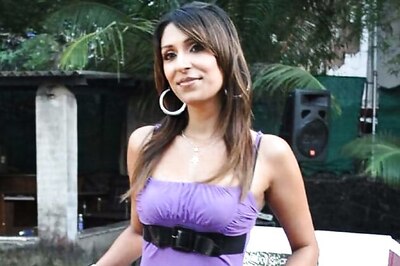
views
Sunita lies on her stomach, her head buried in the sand, her body curled up. Both her arms are stretched out above her, tied with long pieces of cloth, to a rock. She stirs occasionally, rustling the purple nightgown in which she spends her days. Every morning, her mother Mahalakshmi, (who looks like she is in her sixties and frail) buys two cups of tea, unties her, and coaxes her to drink. She sips one, refusing the other and then drops down on the sand again. Sunita, 25, and her mother, have been living on the premises of the Quthbus Sultan Syed Ibrahim Shaheed Valiyullah Dargah here for over two years now, hoping that Sunita’s mental illness will be cured.Sunita and Mahakshmi have no place to go.Mahalakshmi sold everything she had to take her on a long round of various hospitals, including the Institute of Mental Health (IMH), Chennai. “None of it helped. They would give her medicines that made her sleep all day and her body puff up. She would be all right for a few months, and then it would start again: the screaming, breaking everything in the house, running away. I took her to the Ramanathapuram General Hospital but they refused to admit her. Finally, we came here and she is calmer now. But even here, she ran away and fell into a well. So I had to tie her up... If I had come here years ago instead of going to hospitals, she would be all right by now,” Mahalakshmi says.“It might seem inhuman to us to tie up ill people but often, the caregivers just do not know what to do. It’s not like they have many options. They try everything, spending all they have and borrowing more. Government facilities are inadequate. So they stay with their relatives, taking care of them, but keep them restrained. It is not so much the violence they fear, but that they might run away and injure themselves or get lost,” says Vaishnavi Jayakumar, co-founder of The Banyan, an NGO that works in the field of mental illness.Mothers (and some fathers) and their mentally-ill children dot the vast premises of the dargah in Erwadi, famed for its curative powers. People of all faiths from across south India throng in the thousands to its gates, hoping for a miracle to cure their loved ones. The belief: they must stay there until in a dream they are told by the saints to leave. At that point, they are cured and can get on with their lives. This could take anywhere between a few days and several years. Many have sold their homes, their lands and any other possessions they have, to come here. Most subsist by finding daily wage labour, while some others are sent money by their families back home.The dargah feeds everyone on its premises once a day. For many abandoned people there, this is possibly their only meal of the day.Since the fire that killed 28 mentally-ill people in a private ‘home’ here 10 years ago, the government closed all 17 such ‘homes’ in the area, made it compulsory for anyone wanting to run a home to obtain a license and banned chaining of people.But inside the premises of the dargah, things seem to be at an impasse. “Over and over again, we have told people here not to tie or chain their relatives to trees or pillars. We know it is inhuman. They untie them for a while, and sometime later, tie them up again. Some of the people are so violent that it is difficult to control them. What can we do?” asks one member of the Dargah Haqdar Management Committee. Recently, when on the committee’s insistence, some men were untied, one of them ran out and started a bus, another smashed a window and a third broke the headlight of an advocate’s car, he adds.S Anitha does not know how she can manage without chaining up one of her sons.Three months ago, she came to the dargah with her two sons, both of whom are mentally ill. While one, a former heavy tank driver in Chennai, wanders about the premises, the other is chained to a pillar. “I feed them every day, take them to the bathroom and go with them to the river while they have a bath. But there is no saying when they will turn violent. Once, I had to hide in the ladies prayer hall for three days from my son, who was in a murderous rage and threatened to kill me. I have no choice but to keep him restrained,” she says.Anitha took her son to IMH, Chennai, which sent him back in a few months. She then tried many doctors, mortgaging her home for funds, before coming here.“The very violent mentally-ill have to be restrained. We do it pharmacologically, with drugs. But those inside the dargah do not believe in drugs, tie up people they cannot control,” says Dr J Periyar Lenin, a psychiatrist attached to the District Mental Health Programme (DMHP), Ramanathapuram.A few feet away from Sunita, a man is chained to an old, large tricycle. His curly, matted hair covers most of his face, and he doesn’t respond when spoken to. No one knows his name, as he was abandoned here a long time ago. He gets fed occasionally by the people around him, but doesn’t eat much. The burning heat of the sand on which he sits with only a loincloth on him, doesn’t seem to bother him. In a nearby shed, three men are chained to pillars, one of whom is abandoned.DARGAH’S CARE HOME YET TO TAKE OFFIn 2007, V Shahul Riyas, a resident of Erwadi and president of the Hazdar Youth Progress Federation filed a writ petition at the Madurai bench of the Madras High Court against the Dargah Haqdar Management Committee and others, asking for a special home or rehabilitation centre to be set up to house the mentally-ill in the dargah. During the proceedings in 2008, the Dargah Committee agreed to allot two acres of land to build and maintain a rehabilitation centre for about 50 people, at its own cost. The court then directed the district administration to give the committee its full cooperation for this. That home is yet to materialise.Syed Ibrahim, member of the Dargah Committee, informs that they had submitted an application to the government for a No Objection Certificate (NoC), but that this had not yet come. “Also, three years ago we estimated the cost of construction to be Rs 20 lakh. Now it has nearly doubled. We need aid from the government - either a grant or a loan - to help us build it,” he adds.Ramanathapuram Collectorate officials, however, say that the dargah has not approached them for an NOC. “We would have no problem in giving them the NOC as after all, it is their private land. The matter of aid, however, may not be possible,” collector Arun Roy says.GOVT CLAIMS STRIDES IN GIVING TREATMENTAfter the fire, several strides have been made in treating the mentally-ill here. Under the DMHP, launched in 2001, a mobile team, which includes a psychiatrist and psychologist-social worker, visit various parts of the district to diagnose and treat people. Basic medicines are now available at the local primary health centre, which treats 22 mentally-ill patients. Those treated at the PHC however, have to travel to the Ramnad General Hospital for follow-up care or a change in medication. The GH now has a 12-bed psychiatry ward, which is almost always full. A team from the DMHP visits Erwadi every month (it used to be every week until the government fuel allowance was reduced) and examines the mentally-ill, attempting to convince them to both have faith and take medicines, says Dr Lenin. And yet, these measures are woefully inadequate to deal with the influx of patients here. It is an arduous, uphill task, not made easy by the fact that there are only two psychiatrists in Ramanathapuram, and an average of 4,000 patients are treated every month.“Despite all that we do, the demand far outstrips the care that is provided,” says Dr C Rama Subramanian, State nodal officer of the National Mental Health Programme.Meanwhile, in 10 years, not much has changed for the mentally-ill and their relatives. A young man contemplates as he is tied to a tree in the premises. His mother struggles to find work in the village. She believes a wicked spirit possesses her son. The spirit is being slowly pulled out by the powers of the dargah, she says. “My husband and other children are not supportive. They don’t believe this place can cure him, but what I say is, the spirit is so deeply embedded in him, that it will take time. I’m not leaving here till he is cured.”(All names of victims and relatives changed to protect identity)




















Comments
0 comment